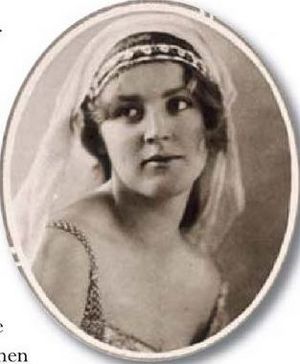Lady Mary Clive facts for kids
Lady Mary Katherine Clive (born Pakenham on 23 August 1907 – died 19 March 2010) was a British writer and historian. She was well-known for writing about her own family and her experiences as a young woman formally introduced to society, known as a debutante.
Contents
Early Life and Family
Lady Mary was born into the Pakenham family, an important Anglo-Irish family. She was the fourth child of Thomas Pakenham, 5th Earl of Longford. An Earl is a noble title, similar to a count.
Childhood Homes and Loss
In 1915, when Mary was young, her father was killed in World War I at the Battle of Gallipoli. Her mother was very sad after his death, which affected her relationship with her six children. Mary spent her childhood partly at North Aston Hall in Oxfordshire, England. She also spent summers and Easter holidays at Tullynally Castle in County Westmeath, Ireland.
Her Talented Siblings
Lady Mary had several siblings who became famous in their own right. Her older brother, Edward, was a politician and helped run the Gate Theatre in Dublin. Her other brother, Lord Longford, was also a politician and worked to make society better. She had three sisters: Violet, who wrote biographies (life stories), Pansy, who wrote novels, and Julia.
Growing Up Different
Lady Mary and her siblings did not have many friends outside their family. She believed this was because their clothes were old-fashioned. Lady Mary remembered that her mother might not have noticed how children's clothes had changed. As they grew older, they became very aware that their appearance was unusual. She said they had to wear "brown, ribbed woolen stockings and brown boots" all year, which made them feel very ashamed.
In her 1964 book, The Day of Reckoning, Lady Mary wrote about her childhood. The Daily Telegraph newspaper said she wrote with sharp observations and a realistic view, which matched her own personality. The Guardian newspaper noted that Mary, like her brothers and sisters, had a strong independent spirit and enjoyed being different.
Christmas Memories
Lady Mary spent her childhood Christmases at her mother's family home, Middleton Park in Oxfordshire. She wrote about these memories in her 1955 novel, Christmas with the Savages.
Life as an Adult
Lady Mary married Meysey Clive, a soldier and landowner from Herefordshire, England. She moved to Whitfield, the Clive family home, in Herefordshire's Golden Valley. After World War II, Lady Mary restored Whitfield to its original Georgian style, removing later additions to the house.
Loss and New Beginnings
In 1943, her husband, who was a colonel in the Grenadier Guards, was killed in North Africa during World War II. They had two children: George, who passed away before her, and a daughter named Alice. Alice later became a High Sheriff of Cornwall, a special role in local government.
After her husband's death, Lady Mary raised her children in a smaller house on the estate called Rabbit Cottage. She lived in Herefordshire, near the Black Mountains, from the end of the war until she passed away. Lady Mary became blind shortly before her death and died in a nursing home at 102 years old.
Working with Family
Lady Mary was also related by marriage to the historian Elizabeth Longford. They often traveled together while researching books. Lady Mary helped Elizabeth find historic battlefields in Spain and Portugal when Elizabeth was researching the life of the famous general, the Duke of Wellington.
Career and Writing
Lady Mary was presented as a debutante in 1926. This was an experience she described in her 1938 book, Brought Up and Brought Out. Her book showed the less glamorous side of being a debutante. She called 1926 a "dowdy year" for debutantes and described some of the men she met as "practically deformed." She also appeared in advertisements for Pond's cold cream during this time.
A Different Path
The 1926 United Kingdom general strike happened in the same year she was a debutante. During the strike, she served tea to striking lorry drivers. People thought her intelligence was a disadvantage for a debutante, so Lady Mary had to pretend she wasn't very smart. After three seasons as a debutante, she decided to get a job. She lived in Chelsea for almost five years.
In 1931, she went on a trip around the world. She started in a fancy hotel in Canada and ended up on a sheep farm in New Zealand. Later, she took a secret solo bicycle trip across France and Switzerland.
Journalism and Books
Lady Mary also worked as a gossip columnist, writing about social events and famous people. She sometimes relied on her younger sisters for interesting stories. Her popular memoir led to Lord Beaverbrook, a newspaper owner, hiring her for the Londoner's Diary section of his newspaper, the London Evening Standard. She nicknamed Beaverbrook the 'Goblin King'. He later made her a chief reporter.
Lady Mary said she started writing for newspapers because it was exciting and paid well. She earned a good amount of money each week for her two columns, one about dresses and another about "intelligent" gossip. Other writers she worked with included Peter Fleming, the brother of Ian Fleming, and John Betjeman. In 1937, Lady Mary wrote for a short-lived magazine called Night and Day, which was edited by Graham Greene.
Lady Mary also wrote two historical biographies: one about the poet John Donne and another about King Edward IV of England. Earlier in her career, between 1932 and 1937, she wrote four novels using the pen-name "Hans Duffy."
Images for kids



